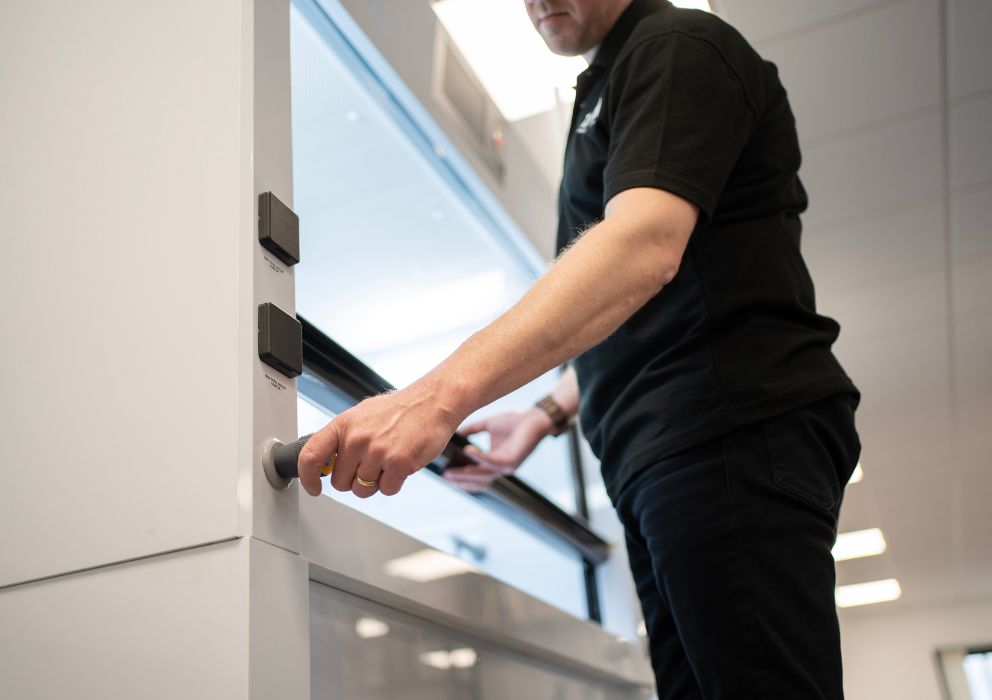
Fume cupboards are a laboratory essential. They help to prevent any exposure of dangerous and potentially hazardous chemicals and substances from coming into human contact.
It is vital that any fume hoods in the laboratory are properly maintained so that they function as intended. Maintenance and safety regulations should be properly adhered to at all times when using a fume cupboard to reduce any risk of personnel injury or laboratory contamination.
Possibly the most common cabinets are ducted and recirculating. Both operate in a similar way by drawing air in through an aperture located at the front, and either filter the air back into the room after removing harmful chemicals or simply expel it from the building.
Your cabinets should be inspected at least once in the period of every 14 months. According to the British Standards, this is a legal requirement. Any inspection certificates and maintenance reports must be documented and kept on file, as well as any certificates that have been provided from the inspection.
Here are some things for you to consider when maintaining your fume hoods and their components:
The Sash – The sash must be kept well lubricated; pulley wires and alignment should be checked and any broken material should be replaced. The glass must be checked for any chemical damage or cracks.
The Fan – An essential element to the fume cupboard, the fan must be working and maintained always. The physical integrity of the fan should be inspected as well as checking for general wear and tear as well as any cabling.
The Ducting – For any cabinet that requires ducting, the duct must be inspected to ensure that it is properly sealed and remains in good physical condition. Fire dampers should be examined for any potential damage that might have been caused, as well as checking the volume control dampers to ensure they move freely.
The Controls – Both electrical and mechanical checks should be performed on controls to ensure there is no wear. The airflow alarm system should be calibrated as well as control valves.
The Enclosure – Checks should be performed to ensure there are no leakages and the structural integrity of the fume hood remains intact.
Any cleaning conducted in your unit must be conducted by a certified professional. And make sure the appropriate PPE is worn at all times when carrying out any cleaning.
When conducting any experiments inside a fume cupboard, the safety of the operator is priority, and is therefore important to keep any materials being used about 150mm inside of the hood, away from the window opening. Keep the sash closed when not in use and be sure to remove any chemicals once you are finished with your experiment, safely storing them in a chemical storage cabinet that is ideally constructed using polypropylene.
Try not to place anything in front of the glass as this has a chance to cause turbulence in the air flow, potentially causing fumes to escape into the laboratory. Be sure to place items at a minimum distance of around 150mm away from the front of the cabinet.
One of the key things to remember when installing a fume hood is that it should not be placed close to any walkways, windows and doors. These may potentially interfere with the air flow and ventilation system. Placing the unit away from these will ensure to help minimise the risk of airborne contaminants spreading throughout the laboratory.
We really shouldn’t need to say this, but not everyone’s level of common sense is the same. Do not use the fume cabinet as a storage cupboard. It should only ever be used for its intended use of conducting experiments. Otherwise, this could lead to chemicals being exposed to the laboratory or potentially interfere with the airflow.
This isn’t like your family member setting up the latest household electronic, so it’s worth ensuring that there you have the instructions nearby to show you how to deal with situations such as a power failure or fire hazard should the events arise.
Just a side note. If you ever experience a fire or power cut, be sure to close the sash quickly before you evacuate the laboratory or building. It’s also worth mentioning that the fume hood will not function without power, which means it can cause a build-up of dangerous chemicals that can be hazardous. And you’ll need to ensure all your staff are aware of any fire hazard procedures, which helps safeguard everybody, as they’ll know exactly what to do if there is a fire.
Read our Privacy Policy for more information on how we collect and process data.



No thank you
Read our Privacy Policy for more information on how we collect and process data.